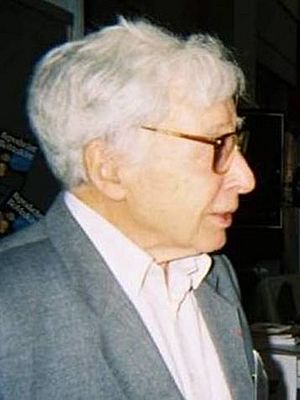Robert Edwards facts for kids
Quick facts for kids
Sir Robert Edwards
|
|
|---|---|

Edwards in 2010
|
|
| Born | 27 September 1925 |
| Died | 10 April 2013 (aged 87) England
|
| Nationality | English |
| Alma mater | University of Wales, University of Edinburgh |
| Known for | Inventing in vitro fertilisation |
| Awards | Nobel Prize in Physiology or Medicine (2010) |
| Scientific career | |
| Fields | Medicine |
Sir Robert Geoffrey Edwards (born September 27, 1925 – died April 10, 2013) was a British scientist. He won the 2010 Nobel Prize in Physiology or Medicine. This award was for his amazing work in creating in vitro fertilisation (IVF). People sometimes call this method making "test tube babies."
He started working on his ideas in the 1950s. The first "test tube baby," Louise Brown, was born on July 25, 1978. His research partner from 1968 was Patrick Steptoe. By 2010, more than 4 million babies had been born using the IVF method.
About Sir Robert Edwards
His Early Life and Studies
Robert Edwards served in the military during World War II. After the war, in 1948, he began studying at the University of Wales. Then, in 1951, he went to the University of Edinburgh. There, he earned his PhD degree.
His studies focused on how embryos developed in mice. In 1957, he had a research job at the California Institute of Technology. He returned to England in 1958. He started working for the National Institute of Medical Research. While there, he began to study how humans become pregnant.
In 1962, he took a new job at the University of Glasgow. But in 1963, he moved to Cambridge University. He went back to the US in 1965. He was a visiting scientist at Johns Hopkins University. Later, he was at the University of North Carolina. He returned to Cambridge and taught physiology from 1969.
How IVF Works
Scientists had some success fertilizing rabbit eggs in a lab. But Edwards soon found that the process for humans was very different. It was much more complicated. He spent many years studying the human egg. He wanted to find the best way to fertilize it with sperm outside the body.
He successfully fertilized a human egg in 1969. However, these early fertilized eggs did not develop further. Patrick Steptoe was a British gynecologist. He had used a special tool called a laparoscope a lot. This tool helped him look inside the body. Using the laparoscope, he could carefully take eggs directly from the ovaries.
Edwards was able to use these eggs. He successfully fertilized them in a test tube. It was actually a special dish called a cell culture dish. This amazing discovery caused a lot of discussion. People debated whether this kind of research should be allowed to continue.
His Family
Robert Edwards' wife was Ruth Fowler Edwards. She was the granddaughter of a famous physicist named Ernest Rutherford. Her father was also a physicist, Ralph Fowler. Robert Edwards had five daughters and twelve grandchildren.
His Death
Sir Robert Edwards passed away on April 10, 2013. He was 87 years old. He died in England after a long illness affecting his lungs.

